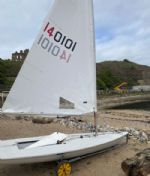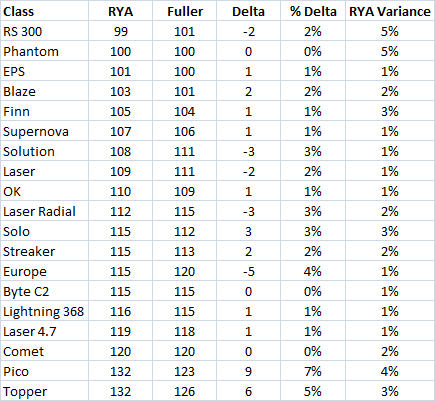











Boats for sale
| Laser 140101 Tynemouth |
 |
| Laser 28 - Excellent example of this great design Hamble le rice |
 |
| Laser 161752 Tynemouth |
 |
List classes of boat for sale |
The Fuller Number |
Post Reply 
|
Page <1 56789 11> |
| Author | |
JimC 
Really should get out more 

Joined: 17 May 04 Location: United Kingdom Online Status: Offline Posts: 6662 |
 Post Options Post Options
 Quote Quote  Reply Reply
 Topic: The Fuller Number Topic: The Fuller NumberPosted: 24 Apr 14 at 1:04pm |
Its a bit of a circular argument, because what he's done is a regression calculation - ie an empirical formula) which aims to approximate the published RYA numbers. So by definition its a reasonable fit to the published numbers. To act as a sanity check for the RYA numbers you'd need a clean sheet VPP based on the physics, and that's quite a different challenge. What's most interesting about it, to my mind, is what the actual formula tells us. It tells us firstly that length is king, more than any other factor, even for planing dinghies, and that sail area is second by quite a way. Not a major surprise I suppose, but a lesson that can always be reinforced. Another thing it tells us is that probably most dinghies are of vaguely similar proportions - if we can gain a reasonable fit from just length, weight and sail area, its suggests that other things like overall beam, waterline beam, wetted area, prismatic coefficient etc are generally in the same sorts of proportions relative to these headline numbers - something that's been explored in some posts above. Other things that will be interesting are the exceptions - boats that are way off the straight line. They may indicate deficiencies in the formula, or they may indicate design choices - if the X is faster than predicted that may indicate a really clever design, or it may indicate a boat in which speed was a higher priority than other factors that are not measured in the formula. Similarly slower than predicted. If the Y was designed as a good solid stable boat that will carry a whole family on a picnic it will probably look slow compared to hotshot racers even for weight and length. Or they may indicate boats for which the observed performance from th PY system is way out: that's possible too. One surprise to me is that the formula came out with speed proportional to length, I'd expect square root of length, but no doubt other formulae are possible and will give interesting results too. Edited by JimC - 24 Apr 14 at 1:16pm |
|
 |
|
Guests 
Guest Group 
|
 Post Options Post Options
 Quote Quote  Reply Reply
 Posted: 24 Apr 14 at 1:04pm Posted: 24 Apr 14 at 1:04pm |
|
It is based on the assumption that RYA PY numbers are correct. If we make the reasonable assumption that for most classes they are not too far off, then this formula may help show up where some anomalies are*, or it may be that the formula is being forced to extrapolate beyond the realms of fairness. I wouldn't expect it to work for a foiling Moth, but it should be reasonable for a Hadron.
* Unless the anomalous boat has been included in the dataset the regression was done on, in which case the formula is infected. I haven't run any race results using these numbers, but feel free to do so. The table below is a set of PY numbers calculated by the formula and compared against 2014 RYA numbers. I have divided by 10 and rounded off, because I can, and because I feel that 4 digit numbers are spurious. The delta column is the difference between the two results and the % Delta is the (absolute) percentage difference, obviously. It is usually within 1-2%, with some clear exceptions. For interest, I looked at the official RYA numbers for each class since 1981 (figures courtesy of JimC) and the last column shows how much variance there has been in the official number over those 34 years (in fact, the vast majority actually happens in the last 4 years for nearly all classes, since the system changed). You can see that variance within the RYA's own numbers is as much as the difference between the prediction and 2014 RYA numbers, so improving the accuracy of the prediction is pointless. Note that that is not the same as saying the RYA PYs are accurate to 2%. The RYA's best guess varies 2% year on year, but could still be 10% out (who knows?). 
|
|
 |
|
Rupert 
Really should get out more 
Joined: 11 Aug 04 Location: Whitefriars sc Online Status: Offline Posts: 8956 |
 Post Options Post Options
 Quote Quote  Reply Reply
 Posted: 24 Apr 14 at 1:35pm Posted: 24 Apr 14 at 1:35pm |
|
Interesting that the Blaze, despite not having wings taken into account, would be faster under the Fuller method, bringing it closer again to the Phantom.
On the Laser handicap (if we have to) one thing that has happened over the last 4 years is that boats which were, on handicap, pretty much level pegging with the Laser (such as the Supernova and Solution) despite having more hitech rigs, are now showing to be faster. Wouldn't this be expected? For years, it looked like no one could design a 14 foot boat that was much faster than a Laser - even the Blaze was within spitting distance. Now, maybe we are seeing the reality. And because of the way the system works, both boats move. |
|
|
Firefly 2324, Puffin 229, Minisail 3446 Mirror 70686
|
|
 |
|
Guests 
Guest Group 
|
 Post Options Post Options
 Quote Quote  Reply Reply
 Posted: 24 Apr 14 at 1:45pm Posted: 24 Apr 14 at 1:45pm |
|
Jim raises some good points. FWIW, this formula gives a slightly better fit than the one I first posted, and it does use a square root of length term. The difference in predicted numbers is only 0.3% though.
PY = exp((8.102887)-(0.49514*(L^0.5))-(0.03296*SA)+(0.001041*((L^0.5)*SA/Disp))) I wonder whether a simple fudge factor could help this further. Set 4 or 5 categories of boat: a. Full on dev boats where every ounce of speed is squeezed out e.g. 14s b. Highly refined racers e.g. 505, Finn, 800 (generally carbon mast, epoxy hull etc) c. Standard boats e.g. laser, 200 (ali masts) d. Beach boats e.g. rotomolds It looks at first glance that if you set a multiplication factor of say a = 0.96, b = 0.99, c = 1.01 and d = 1.05 you would go some way to factoring the 'goodness' of design (in a purist sense) into the equation. |
|
 |
|
AlanH 
Groupie 
Joined: 17 Apr 10 Location: Scotland Online Status: Offline Posts: 84 |
 Post Options Post Options
 Quote Quote  Reply Reply
 Posted: 24 Apr 14 at 2:33pm Posted: 24 Apr 14 at 2:33pm |
|
Interesting stuff. I'd agree with Jim above about importance of length. I currently sail an Osprey, and am impressed by its performance. Upwind, I can hold a 505, and I think the main reason is simply the extra LWL. Against that, the 505 has bigger sail area, is lighter and has more beam, so length must be pretty important to overcome these three disadvantages.
|
|
 |
|
gordon1277 
Really should get out more 
Joined: 24 Mar 10 Location: United Kingdom Online Status: Offline Posts: 665 |
 Post Options Post Options
 Quote Quote  Reply Reply
 Posted: 24 Apr 14 at 2:37pm Posted: 24 Apr 14 at 2:37pm |
|
Hi Peaky
The numbers for the 300 EPS seem at odds or is that just to wind up Grf? When we had Nick Peters in the 300 and Yves Loday in the EPS one evening the 300 won by miles. That was in Solent chop so I would have thought given the advantage to the easier to sail EPS. Good luck with the maths. Gordon |
|
|
Gordon
Lossc |
|
 |
|
Guests 
Guest Group 
|
 Post Options Post Options
 Quote Quote  Reply Reply
 Posted: 24 Apr 14 at 2:57pm Posted: 24 Apr 14 at 2:57pm |
|
Good spot. Maybe Nick's a decent sailor ;)
He is, of course, but it turns out I used justthe hull weight. Add on 25kg for the rest and you get a number of 1030. Don't tell Graeme though. The hardest part is getting good data... |
|
 |
|
JimC 
Really should get out more 

Joined: 17 May 04 Location: United Kingdom Online Status: Offline Posts: 6662 |
 Post Options Post Options
 Quote Quote  Reply Reply
 Posted: 24 Apr 14 at 3:53pm Posted: 24 Apr 14 at 3:53pm |
That's a measured rating system, which the Portsmouth yardstick isn't. Kipling wrote "There are nine and sixty ways of constructing tribal lays,/And every single one of them is right!", and there are probably 69 ways of managing handicap racing, and they're all correct too. I don't think the current scheme (which of course is in the middle of major change of philosophy) is perfect, or ideal, or anything else, but I do think its probably the most practical system the sport can manage at the moment, and what follows is my personal understanding/interpretation. Over the years its changed. It started out in the 1950s simply as an average of the handicaps actually in use at as many clubs as possible, with a means of normalising each clubs data. It moved, fairly quickly I think, to club officers saying what they thought the handicap should be, rather than what they had used that season. That was how it continued until quite recently, based on the club handicap numbers with various increasingly sophisticated numerical tools to make the club numbers as comparable as possible and things like spreadsheets for the clubs to use to adjust their numbers. The criticism of that over the years was that the clubs had become too complacent and were not putting enough effort into recommending variant numbers. When I look at the historical data I've put together I think there's a little evidence that there weren't as many numbers changing as much in the 2000s as there were in the 1980s. I suspect part of that is pyschological, because 90 -> 91 feels like a smaller change than 900-910... Anyway, that's changed now, and the system is in the middle of moving away from the method of numbers based on club recommendations to a new method of numbers based on actual club results - the web system. This brings a whole number of advantages, and also a number of disadvantages, because nothing's perfect. The systems aren't as different as they sound, because the actual functionality behind the web system is using the maths in the tools that were made available to the clubs to calculate the equivalent of club recommended numbers, and then aggregate the club numbers in the same way. So the new system effectively calculates recommendations for every club, whereas before it was considered that many clubs didn't bother to do the calculations and just returned the standard numbers every year. So a big advantage of the new system is that it much more closely represents what's happening on the water, and a feature is that the opinion of the club officer about what the handicap should be, whether beneficial or otherwise, is reduced in influence. But the key point about this system is, rightly or wrongly, its not based on the size of the boat, the length of the boat or anything else. Its based on what actually happened on the water over the last 3 seasons. So, unlike all the many Yacht handicapping rules which have come and gone over last 50 years, its immune from designers gaming the measurement system, 'cos there ain't one! On the other hand it does mean its impossible for the RYA team to create handicaps for new boats until there's enough data in the system, and if boats don't maintain a certain level of activity they'll be dropped from the published lists. So basically, whilst in a measured rating system numbers change because the boats have changed, in an observed performance system, which PYS is, numbers change because the performance on the water has changed, and the system doesn't need to attempt to collect data about boat changes. Nothing wrong with either way of doing things: they're just different. Edited by JimC - 24 Apr 14 at 4:49pm |
|
 |
|
blaze720 
Really should get out more 
Joined: 28 Sep 05 Location: United Kingdom Online Status: Offline Posts: 1635 |
 Post Options Post Options
 Quote Quote  Reply Reply
 Posted: 24 Apr 14 at 3:54pm Posted: 24 Apr 14 at 3:54pm |
|
Peaky
Might be worth looking at the 'Great Lakes' (aka Sailjuice) numbers seriously as well. Not everyone likes them of course but the racing is very close and despite the name I think you will find they are just as usable on the sea ... after all the 'Portsmouth' name does not imply it is only useful on the sea and around that part of the Solent. The advantage of the GL approach is so many classes race each other at the same time, on the same water, on the same winds and the crew standard is generally consistently high. The Portsmouth one makes massive assumptions in so many areas because much important 'stuff' can be difficult to quantify. It is however interesting stuff ... but how can 'Fuller' cope with development classes ? A hell of a lot of money would be wasted if innovation and difference made naff all difference ! Hull form for example is very difficult to assess 'dry' as there are just so many possible variables and permutations within these classes. And if these differences make so much difference within single classes what of grosser differences between classes ? Devils advocate warning over ! .. Now issue a set of 'Fuller rules' and see what people design to 'get the better' of the system... Now just exactly where are we all heading in an handcart ? Mike L. |
|
 |
|
JimC 
Really should get out more 

Joined: 17 May 04 Location: United Kingdom Online Status: Offline Posts: 6662 |
 Post Options Post Options
 Quote Quote  Reply Reply
 Posted: 24 Apr 14 at 4:06pm Posted: 24 Apr 14 at 4:06pm |
OTOH a well sailed 300 ought to be able to slice through a chop an EPS would get stopped by. Hard to judge anything by a single instance. |
|
 |
|
Post Reply 
|
Page <1 56789 11> |
| Forum Jump | Forum Permissions  You cannot post new topics in this forum You cannot reply to topics in this forum You cannot delete your posts in this forum You cannot edit your posts in this forum You cannot create polls in this forum You cannot vote in polls in this forum |
Bulletin Board Software by Web Wiz Forums® version 9.665y
Copyright ©2001-2010 Web Wiz
Change your personal settings, or read our privacy policy
Copyright ©2001-2010 Web Wiz
Change your personal settings, or read our privacy policy











 Printable Version
Printable Version Delicious
Delicious Digg
Digg Facebook
Facebook Furl
Furl Google
Google MySpace
MySpace Newsvine
Newsvine reddit
reddit StumbleUpon
StumbleUpon Twitter
Twitter Windows Live
Windows Live Yahoo Bookmarks
Yahoo Bookmarks Topic Options
Topic Options